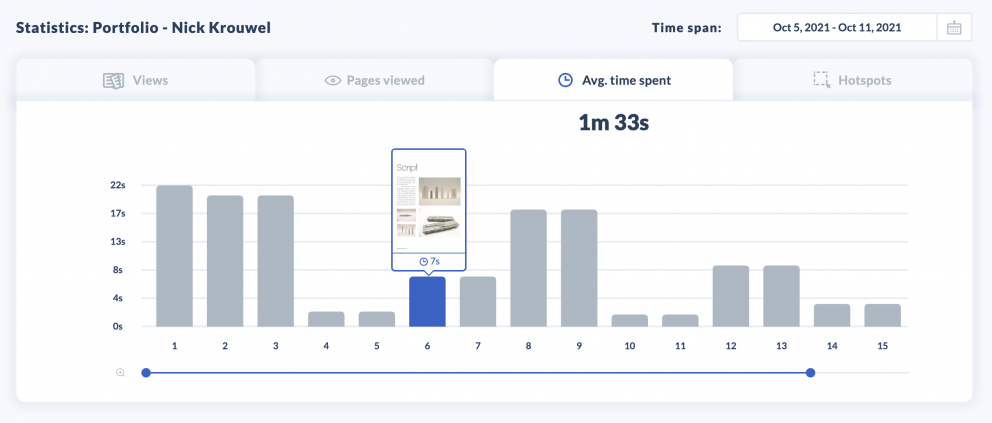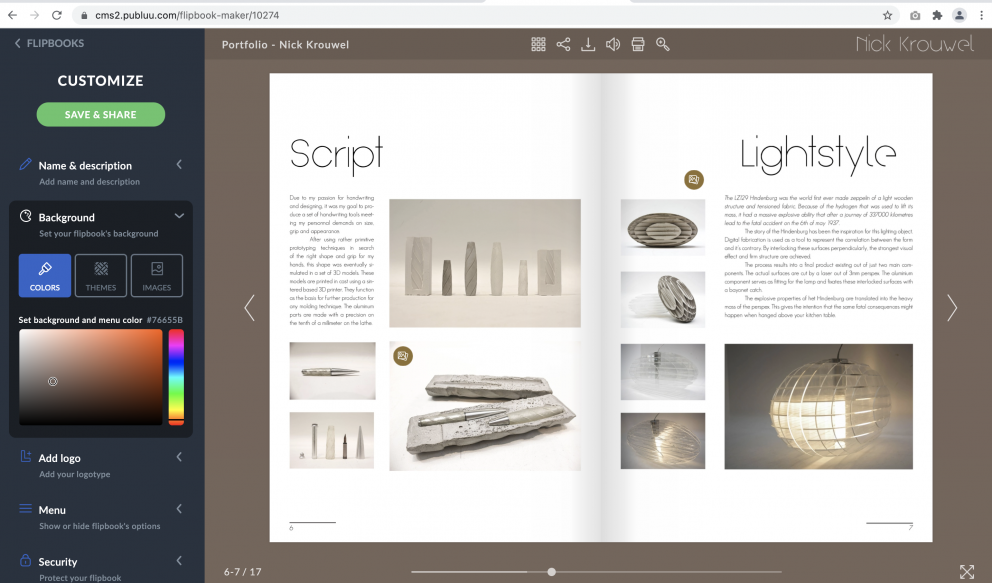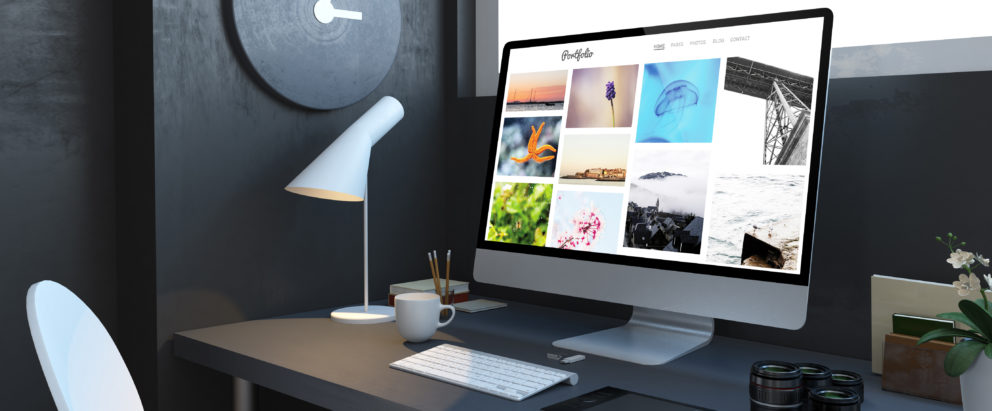Creating a Graphic Designer Portfolio
Every designer needs a graphic design portfolio. It's an essential tool to showcase your skills and completed projects, helping you attract new clients. However, creating a stylish and elegant design portfolio isn't always straightforward.
A high-quality portfolio, whether it's a PDF presentation, a digital portfolio, or a portfolio website, is more than just a gallery of your past work. It's your chance to highlight your diverse abilities, personality, and versatility, ideally landing your next big opportunity.
In this article, you'll discover several tips on creating an online portfolio, organizing your graphic work, using the flipbook format for a graphic portfolio, and presenting it to potential clients and employers. Keep reading to learn more about building a portfolio.
Select Only the Best Works for Your Graphic Design Portfolio
If you're a graphic designer or illustrator, you might have just finished a stunning new illustration. It's tempting to display it in your design portfolio, but consider if it's truly the right fit. Remember, a designer's portfolio should showcase only your best work.
It's hard to determine how many pieces are too many for a portfolio. You never know which of your works will resonate with viewers or bore them. Like a model selects only the most captivating photos for their model portfolio, you should choose pieces that will grab the right client's attention. Start with a dozen high-quality designs that highlight your greatest achievements to make a strong impression.
Tracking Your Viewers with Publuu
Publuu offers something unique for graphic designers, especially compared to platforms like Behance. With Publuu, you can track who views your portfolio. Create exclusive links for potential clients, and easily check if a particular design studio has viewed your work using Publuu's tracking features. You'll be notified anytime someone opens your portfolio.

That's not all Publuu's analytics can do. See how often people open your designer portfolio and which pages or designs they focus on. This feedback is valuable for improving your portfolio layout or design collection, helping you attract new clients or partners.
Use Your Best Work
Inconsistency in project quality can deter employers. Seek honest feedback from colleagues or mentors, and refine or remove weaker pieces. Feedback helps you understand how others perceive your work. Ask fellow designers or friends to role-play as clients and rate your designs.
Put Only the Best Graphic Design Projects in Your Portfolio
Ensure your portfolio contains only your best, most impressive designs. Art directors often don't have time to evaluate numerous illustrations. Aim to be the designer whose first project captivates viewers, prompting them to reach out. Only your best designs can achieve this.
On platforms like Behance, your work can be recommended by viewers, helping you find freelance clients. Choose the right platform to display your work, and people will share your portfolio.
Highlight your best work, not everything. With short attention spans today, be selective about what you show and why. You can include all your work in an online gallery on your graphic portfolio website.
Deviate from this rule to showcase your versatility. Include experience with vector graphics, photo manipulation, animation, and more. List who you've worked with, and clarify your role in group projects. Mention mentors with good credentials if you're just starting in graphic design.
Create a Graphic Design Portfolio with Publuu

Publuu flipbooks are a perfect blend of a portfolio website and a booklet-style portfolio. They allow you to showcase work across drawing, teaching, design, architecture, sculpture, photography, and more. Beyond PDFs and websites, they offer interactive links, video and mp3 uploads, and social media integration.
Flipbooks provide a fantastic page-turning effect and integrate seamlessly with your website! Share them via blog, email, or social media to reach more readers. They're easy to open on any device, ensuring consistently perfect visual design. Simply upload a PDF to convert it to a flipbook, then embed your portfolio on your website.
A portfolio is essential for any freelance designer to showcase their work. An online portfolio centralizes your best work, and flipbooks let you create multiple portfolios. This digital format accommodates PDFs, photos, videos, and audio files. You can add multimedia. Access your portfolio from any device, be it phone, computer, or smart TV.
Create a Unique Portfolio Website
Today, a graphic design portfolio is often a single website or online gallery. A portfolio website showcasing your best work is a fantastic way to share your achievements globally. Digital portfolios can be regularly updated, unlike print portfolios which are often static. Choose the right platform for your graphic design portfolio website to easily edit, add, or remove images as needed.
The best solution for a portfolio website is your own site with a unique domain. You don't need web design skills to choose a good portfolio template and display your work for free. If you're not ready to build a website from scratch, use website builders to create an elegant portfolio site. Post your work online, adjust order and display, and align typography, white space, and design style with your personal brand identity.

Don't limit your online portfolio; showcase all of your outstanding work. Your designs can reach a worldwide audience, from Beijing to New York, potentially being shared overnight. An art gallery on a design portfolio website offers great opportunities.
However, there may be occasions where a digital portfolio isn't ideal. In interviews or meetings without Wi-Fi, a PDF portfolio stored on your device can be invaluable.
While few need a printed portfolio today, having high-quality prints of your best work can impress. A tangible portfolio might not hurt your chances, and it can help convey your commitment.
Having a gallery on creative platforms like Dribbble or Behance is beneficial—but don't overdo it. Share your work, gain followers, and post examples there. Share your portfolio on Facebook, Instagram, or Twitter. A professional artist profile outside your portfolio site enhances your chances of finding commissions.
Put a Part of Yourself in Your Graphic Design Portfolio
Your portfolio should reflect who you are—whether it's a website, printed brochure, or Publuu flipbook. Being a graphic designer is about self-expression and sharing what brings you joy in your art. While it's clichéd advice, it's important.
Designing, even commercially, involves personal preference and association. Your portfolio should highlight your passions and favorite design elements for potential clients. You always infuse your art with a part of yourself. A good designer is passionate about design and can convey that in their portfolio.
Don't overdo it: too much passion in your online portfolio can come off as unprofessional. The portfolio's purpose is to showcase your abilities, which involves showing your personality. Present yourself, your design process, and interests through your portfolio, using your work, branding, content presentation, and text.
Share your design process, challenges, and stories. Contextualize each piece in your portfolio to show how you tackle projects and solve problems. Doing so highlights skills not immediately obvious. Showcasing your personality through design is likely inevitable.
Your portfolio is more than just an ability showcase. Each project is a story about you. Engage customers by sharing your story, making them want to work with you. Past achievements, sketches, photos—all reflect your interests. If you have award-winning work, don't just show it—write about how you earned the award. Mention education, but don't overdo it. Highlight prestigious qualifications like New York School of Design, but don't boast if you're experienced.
Build Your Graphic Design Portfolios by Any Means Necessary
As a beginner, finding enough work for a portfolio can be tough. Many suggest creating extra work beyond client projects, like side projects, pro bono work, and competition entries. For beginners, expanding your graphic design portfolio isn't wrong.
Starting out, you won't have a large portfolio. Find gigs with non-profits by producing promotional materials. Approach local businesses—if you dislike their logo, send them improved sketches. Web designers can contribute to local causes and activist representation. In return, these companies should ideally offer portfolio references.
Create All Sources of Content
As a freelancer, create content for yourself. Are you a web designer? Your website should serve as your ideal portfolio. Build your brand identity as a freelance graphic designer. Art directors are more inclined to work with you if they see quality work you did for yourself.
Creating content for a fictional company is another way to expand your portfolio. If you have experience, consider prestigious projects and create mock-ups, false case studies, and fictional designs using pre-made assets. This adds to your portfolio, develops new skills, and offers creative freedom over the design process. Clients won't mind if the designs are fictional; it's a testament to your creativity and resourcefulness.
Work with stock graphics and accept professional commissions. For beginners, commercial success might be challenging and time-consuming. Every small gig counts. Focus on doing the work rather than worrying about attracting new clients. Small jobs and tasks pay bills and expand your portfolio with samples for your website.
Organizing Your Design Portfolio
How should a portfolio be organized? Present various aspects of a project together, working on a single design to create a large project. To showcase a new technique, use related works and combine them, devoting a few flipbook pages or a section on your portfolio website. Consider portfolio organization principles before presenting projects.
Do you want to narrate your personal development? Should works be presented chronologically? Think about your work and highlight any special connections. The creative director browsing your portfolio should sense what drives you as a designer. Images and projects aren't the only storytelling tools—creative color, typography, and white space usage can help create your portfolio narrative.
Assemble a portfolio for potential clients who should understand your message. If unsure, begin simply: present current work on the first few pages to grab attention, then demonstrate how you developed design skills in the rest.
Plan Your Graphic Design Portfolio Ahead
Many designers get excited about ideas without planning execution, leading to spontaneous, chaotic efforts. This can overwhelm you, making your portfolio unmanageable. Ensure clear goals and portfolio components are as clear to outsiders as to you. Draw a diagram or write an outline explaining your organizational choices.
Show or explain your idea to a coworker or another visual design specialist for feedback on your organization. It's wise to have your text proofread, especially if crafting a portfolio in a foreign language. Employers and clients want to see completed work and seriousness in your application.
Avoid putting effort into a stunning portfolio with great art direction that gets rejected due to misspellings or grammatical errors.
How to Present Your Portfolio?
Work on your portfolio presentation. If presenting in person, practice discussing each slide or flipbook page, explaining image preparation and design creation. Once you have a presentation vision, share it with friends for feedback on your art presentation.
Your work should speak for itself. When presenting a portfolio, avoid detailing every piece. Explain creation, inspiration, or sentimental value, but too much info overwhelms clients. Use opportunities to differentiate, convey personality, and showcase skills.
Seek feedback on your portfolio's organization, content, structure, and impression from mentors, friends, or designers. Consult professionals, especially if a student—career advisors at colleges may review portfolios for free.
A great portfolio can help you start working with new clients, boosting business success and efficiency. Use these tips to create your portfolio, and publish your presentation on Publuu!